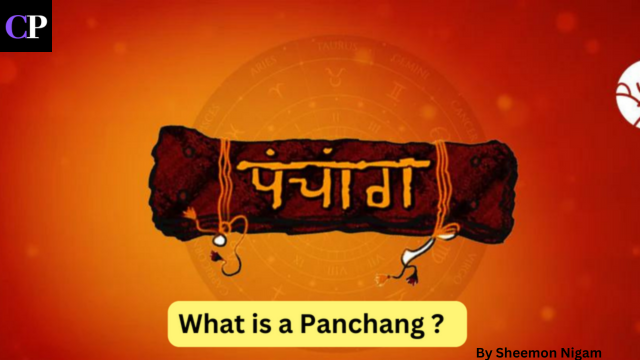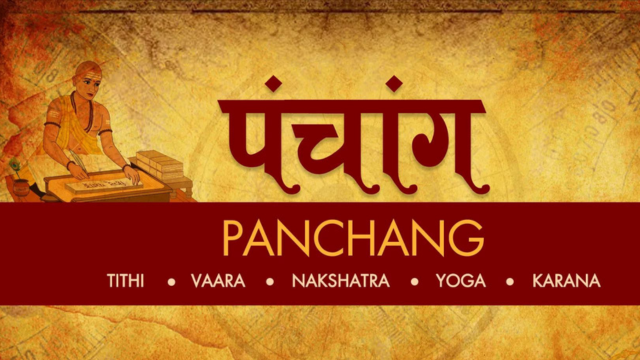What is a Panchang ?

Hinduism or Sanatan Dharma is full of diversity or it would not be unfair to say that Hinduism is a way of life. In Hindu religion and Vedic astrology, fasts, festivals, festivals, calendar, and Muhurta have special importance, without which no festival can be imagined in Hindu religion. From Holi to Diwali, many auspicious dates and festivals have great importance in Hindu religion and the basis of all these is Panchang. Panchang is called the Hindu calendar.
Why it is called Panchang ?
The Hindu calendar is a calendar considered by Hindu society and in its different forms, it is followed almost all over India. Panchang or literal meaning is Panch + Anga i.e. five organs, this is what Hindus call the traditional calendar or Kaldarshak made according to the method of time calculation. The Hindu calendar i.e. Panchang also has 12 months. There are two pakshas of 15 days in each month: Shukla Paksha and Krishna Paksha.
Two Ayanas in every year
There are two Ayanas in every year and 27 constellations keep moving in the zodiac signs of these two ayanas. The practice of keeping a year of 12 months and a week of 7 days started from Vikram Samvat. The month is calculated based on the movement of the Sun and Moon and these 12 zodiac signs are twelve solar months. Sankranti occurs on the day the Sun enters the zodiac sign. The months are named based on the constellation in which the Moon is on the day of the full moon. The lunar year is 11 days, 3 hours, and 48 moments shorter than the solar year. That is why every 3 years a month is added to it which is called Adhik Maas, Mal Maas, or Purushottam month.
Shukla Paksha and Krishna Paksha
Each month has thirty days and the month is divided into Shukla Paksha and Krishna Paksha based on the waxing and waning phases of the Moon. A day is called Tithi which ranges from 19 hours to 24 hours depending on the calendar. The day is divided into 24 hours as well as 8 prayers. One prahar lasts for about three hours. There are approximately two clocks in an hour, a moment is equal to approximately half a minute and there are twenty-four moments in a moment. If seen according to Prahar, there is a day of 4 Prahar and a night of 4 Prahar.

The name Panchang is due to it being made up of five major parts, which are as follows:
Tithi
A phase of the moon is called Tithi. A Tithi is formed due to the interval between the Moon and Sun being equal to 12 degrees. When the difference is 180 degrees, that time is called Purnima and when this difference is 0 or 360 degrees, that time is called Amavasya. There are approximately 30 dates in a month.
15 of Krishna Paksha and 15 of Shukla Paksha. Their names are as follows:
- Pratipada
- Dwitiya
- Tritiya
- Chaturthi
- Panchami
- Saashti
- Saptami
- Ashtami
- Navami
- Dashami
- Ekadashi
- Dwadashi
- Trayodashi
- Chaturdashi
- Full Moon (Shukla Paksha)- Poonam and Amavasya – No Moon (Krishna Paksha)
Vaar
The period from sunrise of one day to sunrise of the next day is called Vaar. There are 7 Varas which are named after the seven planets:
- Sunday (Surya)
- Monday (Chandra)
- Tuesday (Mangal)
- Wednesday (Budh)
- Thursday (Brahaspati)
- Friday (Shukra)
- Saturday (Shani)
Nakshatra
A group of stars is called Nakshatra. Each Nakshatra has 4 phases and by combining 9 phases a zodiac sign is formed. There are 27 Nakshatras who are considered in the Puranas to be the daughters of Prajapati Daksh who were married to Chandra, whose names are as follows:
Ashwini
Bharani
Krittika
Rohini (Chandra loved his wife Rohini the most due to which other wives were unhappy. That is why Daksh cursed Chandra to lose his radiance and later Chandra got his radiance back by doing penance to Lord Shiva. This is the reason why The brightness of the moon increases and decreases per side.)
- Mrigashira
- Adra
- Punarvasu
- Pushya
- Ashlesha
- Magha
- Purva Phalguni
- Uttara Phalguni
- Hast
- Chitra
- Swati
- Vishakha
- Anuradha
- Jyestha
- Mull
- Purvashadh
- Uttarashadha
- Shravan
- Ghanishtap
- Shatabhisha
- Purvabhadrapad
- Uttarabhadrapad
- Revathi
Yoga
Yoga is formed by the combination of the Sun and Moon. These are also 27:
- Vishkumbh
- Priti
- Ayushman
- Saubhagya
- Shobhan
- Atigand
- Sukarma
- Grati
- Shull
- Gand
- Vradhi
- Dhruv
- Vyaghat
- Harshal
- Vanka
- Sidhi
- Vyatipat
- Varian
- Paridhi
- Shiva
- Sidh
- Sadhya
- Shubh
- Shukla
- Brahma
- Aindra
- Vaighriti
Karan
Half of the Tithi is called Karan i.e. there are two Karans in one Tithi. Shakuni in the second half of Chaturdashi (14) of Krishna Paksha, Chatushpada in the first half of Amavasya, Naga in the second half of Amavasya, and Kistughna Karana occurs in the first half of Pratipada of Shukla Paksha. Vishti Karan is called Bhadra in which auspicious works are considered prohibited. Their names are as follows:
- Bav
- Balav
- Kaulav
- Taitil
- Gar
- Vanijya
- Vishti (Bhadra)
- Shakuni
- Chatushpad
- Naag
- Kinstughan
Based on this calculation, there are three sections of Panchang :
Moon-based
The month which is formed by the waxing and waning phases of the Moon (Krishna and Shukla) is called Chandramaas. These are of two types: ‘Amant’ month which starts from Shukla Pratipada and ends on Amavasya is the main lunar month and ‘Purnimant’ which ends with Krishna Pratipada is the secondary lunar month. It is also of 29, 30, 28, and 27 days according to the variation in date. The months are named after the constellation in which the moon is on the day of the full moon. Due to being 11 days, 3 hours, and 48 moments shorter than the solar year, one month is added to it every 3 years.
Since the solar month is 365 days and the lunar month is 355 days, there is a difference of 10 days every year. These ten days are considered as lunar months, yet such extended days are called ‘Malmas’ or ‘Adhimas’. The names of the 12 months are named after the 12 constellations in the sky. The month is named after the constellation in which the moon is visible from the beginning to the end of the night or we can say that the constellation in which the moon is present on the full moon day of the month.
Below is the description of the names of the lunar months and the constellations related to them:
- Chaitra (Chitra, Swati)
- Vaishakha (Vishakha, Anuradha)
- Jyeshtha (eldest, original)
- Ashadh (Purvashadh, Uttarashadh)
- Shravan (Shravan, Dhanishtha, Shatabhisha)
- Bhadrapada (Purvabhadra, Uttarbhadra)
- Ashwin (Revati, Ashwin, Bharani)
- Karthik (Kritika, Rohini)
- Margashirsha (Mrigashira, Ardra)
- Paush (Punvarsu, Pushya)
- Magha (Ashlesha, Magha)
- Phalgun (East Phalgun, Uttar Phalgun, Hasta)
Constellation-based
The group of stars situated in the sky is called a constellation. Generally, it is associated with the path of the Moon. At one place in Rig Veda, the Sun has also been called a constellation. Other constellations include Saptarishi and Agastya. Making astrological calculations from constellations is a part of Vedanga astrology. The constellations are like milestones of our celestial sphere which reveal the vastness of the sky. Although there are 88 constellations only 27 are considered to be on the lunar path, details of which are given above. The Moon moves in the constellation from Ashwini to Revati which is called Nakshatramas which is about 27 days.
The house lords of the constellations are:
- Ketu: Ashwin, Magha, Mool
- Shukra : Bharani, Purva Phalguni, Purvashadha
- Surya : Kartik, Uttara Phalguni, Uttarashadha
- Chandra : Rohini, Hasta, Shravan
- Mangal: Mrigashira, Chitra, Shravishtha
- Rahu: Adra, Swati, Shatabhisha
- Brihaspati : Punarvasu, Vishakha, Purvabhadrapada
- Shani : Pushya, Anuradha, Uttarbhadrapada
- Budh: Ashlesha, Jyestha, Revathi
Sun based
Solar month starts with the solstice of the Sun and the time from one solstice of the Sun to the next is called Solar month. This month usually lasts for 30 or 31 days and in the month of Phagun (February), it has 28 and 29 days. The solar month (solar year) is 365 days. 12 zodiac signs are considered as twelve solar months and Sankranti occurs on the day in which the Sun enters the zodiac sign. The new month of Saur month is considered to begin with the entry of this zodiac sign. The Sun remains in Capricorn from the transition to Sagittarius till the transition to Capricorn, which is called Dhanurmas.
This month has special significance in Panchang. There are two parts of the solar year: Uttarayan: When the Sun is towards the North Pole, then according to Hindu religion it is the time of pilgrimage and festivals. According to the Puranas, the importance of pilgrimage in the month of Ashwin and Kartik has been explained. Paush-Magh month is going on at the time of Uttarayan. On the day of Makar Sankranti, the Sun becomes Uttarayan while the Sun enters Capricorn from Sagittarius. In Mahabharata, grandfather Bhishma had chosen Uttarayan to sacrifice his body. Dakshinayan: Dakshinayan occurs when the Sun enters Cancer. Dakshinayan is the time of fasts and fasting while Ashadh or Shravan month is going on according to the lunar month. Fasting cures diseases and sorrows. Marriage and Upanayana etc. rituals are prohibited in Dakshinayan.
The names of Sauramas are:
- Aries
- Taurus
- Gemini
- Cancer
- Lion
- Virgo
- Libra
- Scorpio
- Sagittarius
- Capricorn
- Aquarius
- Pisces